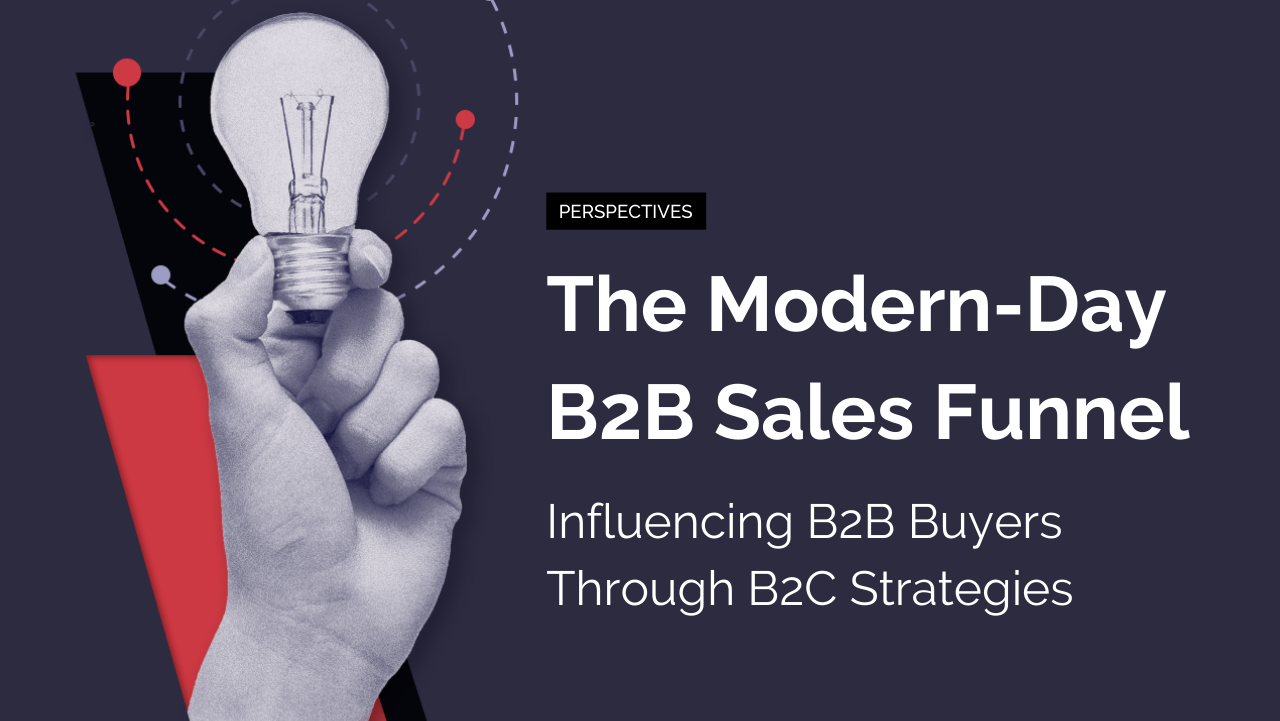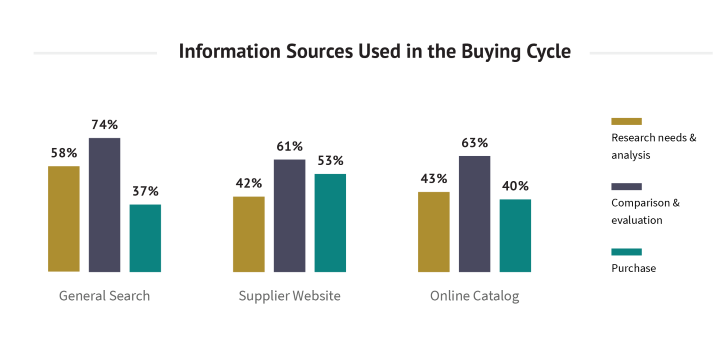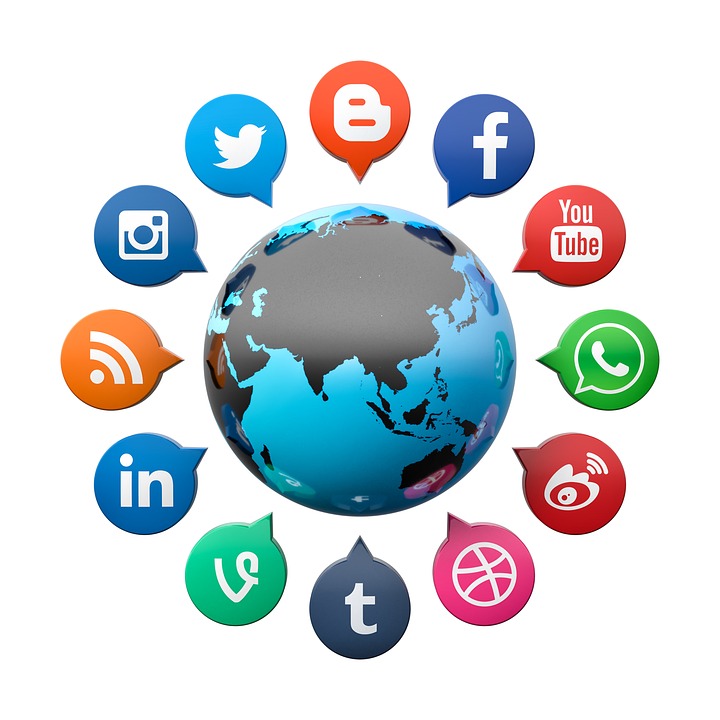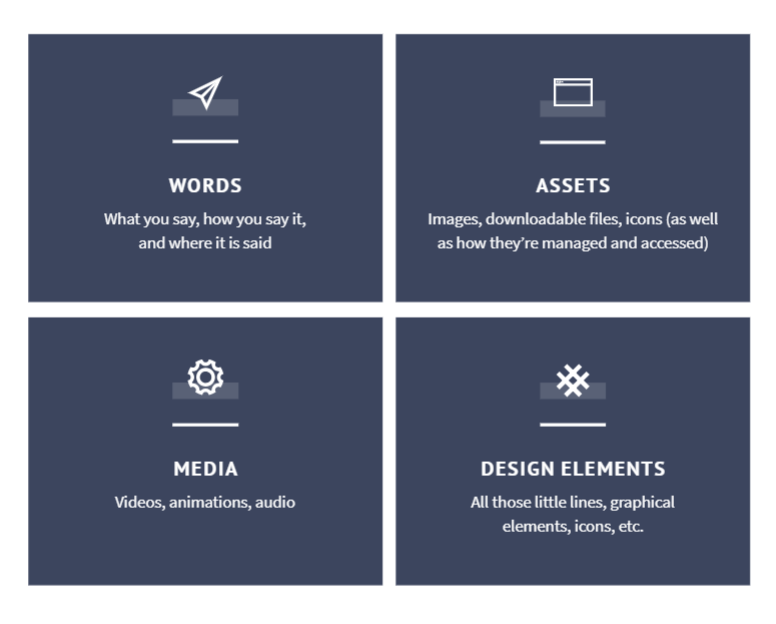The Modern-Day B2B Sales Funnel: Influencing B2B Buyers Through B2C Strategies

As consumers, we can all look back and recognize that internet has given us all a huge advantage when it comes to the purchasing process. The emergence of user-friendly eCommerce and a wealth of online content continues to assist us in finding the products and services we seek, comparing them against various providers, and ultimately landing at the best option for ourselves. But as sellers, the internet has done just the opposite; it’s made things a lot more complicated! And for manufacturers and sellers who sell to other sellers (B2B), it’s become doubly confusing.
But the internet is only one piece (albeit, a giant piece) of the digital technologies that drive present-day marketing initiatives which heavily influence online buying behaviors. In any industry, various technologies are now key components to the modern-day sales funnel and embracing the power of these new tools is 100% necessary if you want to stay relevant to your market, your customers, and other businesses.
But, before diving into how the B2B sales funnel has evolved into its modern state, it’s important to understand the modern shopping behaviors at play and how B2C experiences have shaped our overall expectations as buyers.

Modern Shopping Behaviors
As you’re aware, the way that we all shop and make purchases has completely changed. Brick and mortar stores are constantly being replaced by virtual shops optimized for an online shopping experience. As consumers living in a complex and ever-changing era, we’re all about the buying simplicity evolving on the web. Thus, we expect things to be easy and quick and our behavior as shoppers is changing. But these BIG shopping behavioral changes aren’t only relevant to B2C players.
Though slower to evolve, the B2B industry is also seeing a drastic shift in the way their customers research, find, consider, purchase and interact with all types of businesses, products and services. In fact, a recent study showed that 90% of B2B buyers say online content has a moderate to major effect on their purchasing decision.
This means that, essentially, the entire sales funnel as we know it has been reimagined in a matter of 20 years—at least for 9 out of 10 B2B buyers, anyway. So how has the sales funnel changed? And what are the digital tools bolstering it?
The Sales Funnel
The concept of the sales funnel is still pretty much the same as it ever was; that is, your sales all come your way through a metaphorical funnel. The top of the funnel is the widest, and encompasses just about anyone who will shop or research the products or services your business provides. These prospective buyers (prospects) travel down through various funnel stages (awareness, consideration, ready-to-purchase) and, eventually, a small percentage (conversion rate) of them become a sale. Ideally, after the narrowest part of the funnel, these prospect-turned customers then exit the sales funnel and enter into a different processes aimed at retaining and even upselling them.
Again, the funnel itself, or at least the broader concept, hasn’t really changed all that much. But as marketers, how we move customers through the funnel has changed. And, the tools we use to move people through the funnel serve many purposes, across all the sales stages.
To start, getting people entered into the funnel is easier said than done. There are a countless number of ways to clear first critical first hurdle, all of which hinge on one key question:
Who is your audience?
Identifying Your Buyers
Identifying your buyers in a digital age is still as challenging as it was traditionally. One thing that has remained consistent, though: all buyers are humans (at least as of this writing). Even if you are a B2B company, there is a human behind the purchasing decision.
Yes, that human works for a business, which your product ultimately serves; but at the end of the day, a human is still deciding to purchase or not, not an entity. Another human (or maybe even the same person) will then have to implement and use the product or service. And as a result of your exceptional products or services, a human somewhere now has an easier time doing their job than they did before…hopefully, anyway. Seeing as how 9 out of 10 B2B executives (who are also humans) rely on internet research before making a purchasing decision, the internet is where you should start your buyer identification and target audience personas.
Developing Personas
With all these faceless web surfers out there, developing buyer personas has become something of a niche speciality. Developing a persona for your online audience is a crucial component of a successful B2B, particularly for the sales and marketing departments. After all, your marketing team needs to know who they’re marketing to, and the sales team needs to know who—you guessed it—they’re selling to! This is your target audience. To identify them, start by answering one convoluted question: What are your ideal customer demographics?
Collecting demographic information is a great place to start coming up with your personas. This of course opens the door to myriad other questions, like:
- Where do your customers hang out online? And how much time do they spend online?
- What forums do they use to communicate?
- What’s their educational background or technical savviness?
- What methods and tactics are they using to gain their information?
- Which industries does their company serve?
- What is their job title? Responsibilities?
- What type of buyer are they: emotional or logical?
- Who are the influencers or thought leaders they follow?
This is just a small sample of the things that a solid digital persona should aim to cover. There’s a lot of data analysis in understanding your buyers, and there are likely to be several different types of buyers, each with a unique personality. You’ll need to strategically (and constantly) leverage this data, because their persona helps inform how you can reach each of them. In our modern world, AI-enabled technology can help you not only locate and engage with each unique persona, but also continue to market to them with increasing relevancy and personalization.
Once you’ve landed at a persona (or several personas) that accurately represents your target buyer(s), you’ll then want to examine what makes them tick, what problems they’re experiencing that your product or solution solves. Then, of course, how to reach them.
Buyer-Behavior Process
The B2B buyer-behavior process is quite different from the B2C buyer-behavior process. To get your B2B customers from the problem-recognition point to the final purchase, you need to guide them through the complex and constantly-evolving buyer process with skill and ease.

As mentioned above, the data needed to build your buyer personas will also directly impact how you approach the buyer-behavior process. For example, you can use your data to:
- Understand what your audience is searching for online, then target those keywords.
- Figure out what devices your customers are primarily using to perform these searches (whether they be mobile, desktop, or something else entirely).
- Determine which channels are best to engage with your customers by revealing where they are spending time online, or what industry forums/websites they trust the most.
- Prioritize your customers’ needs, wants and biggest challenges, and then address them with messaging hierarchies.
Based on the current funnel stage in which your buyer currently resides, you might message them differently or distribute your content on different channels where it’s most likely to reach them.
Top of the Funnel
The top of the funnel is all about raising awareness of your company and its offerings. Digitally, this is the most crowded part, but hopefully, your developed personas have provided you with some guidance as to where you want to raise awareness, and with whom.
Awareness
Awareness is exactly what it sounds like: raising recognition for your product, services, or brand amongst your target audience. For B2B organizations in particular, this is the part of the funnel that has changed the most over the last few decades.

Paid Awareness
Paid print ads, billboards, etc. are still a thing, and can still be effective in certain instances or markets, but paid awareness is now more commonly bought online in the form of search ads, social media ads, banner ads, among others. The largest benefit to paid digital advertising is the ability to target specific individuals based on demographics or even persona. Not only that, but showing ROI for digital advertising spend is easy with intuitive budgeting criteria and reporting features built into most tools.
Organic Awareness
Digital has a clear advantage when it comes to raising awareness organically. More specifically, search engines are much more reliable and accessible than tools of the past (sorry, Yellow Pages). So any business’ hope to be recognized for the products and services they offer, even in the b2b space, hinges upon their ability to maintain a web presence that is findable. But, visibility is the bare minimum and won’t get you very far considering there are 3.5 billion search queries per day and it’s more common than not for a website to become lost in the vastness of search engine results. That’s where SEO becomes important.
Search Engine Optimization
Search engine optimization (SEO) is the process of optimizing your website, webpage, or whatever you want to be visible to search engines. SEO helps at nearly every level of the funnel. A person may stumble upon your website from a related keyword search, or when simply searching for your company directly. Regardless of the searchers intent, to get your brand and products in front of them your website needs to be visible, rich with content, highly-functional, and free of technical glitches.
That’s why SEO is more like an ever-changing art as opposed to a set-in-stone science. There are not only seemingly endless rules to follow, and those rules and guidelines are constantly shifting. This has led to several myths and misconceptions regarding SEO in general. Basically, search engines really favor websites and pages that:
- Have quality content and words that are relevant to the rest of the website
- Load quickly and are mobile responsive
- Feature several different forms of media and content
- Is an authority on the web (measured by incoming links or backlinks)
- Is structured optimally so that the search engines know what content takes priority and how to render it to searchers
- Users actually visit and engage with (traffic, bounce rates, etc.)

Social Media
Social media encompasses all of the newer (and sometimes older) social tools that have become almost as prevalent as the internet itself. Regardless of your opinion on or personal usage of social media, there’s no denying that it’s become an integral part of daily life for customers and prospects the world over.
Related to the sales funnel, social media platforms have evolved into a place for people to have intimate discussions about brands, an opportunity that was never available before. If you’re not there to interact with that audience, you have no control over your story. And they’re not only chatting about B2C establishments. They could be talking about your B2B, manufacturing or industrial business and there are even specific forums on which these conversations can and do take place.
Every single status, tweet, and photo you post is an opportunity to tell your current and future customer base your brand story. It allows you to create a unique personality, one that’s in line with your company values and mission, while also humanizing it in a way that’s not possible otherwise. And as an added bonus, a presence on social media actually helps you rank higher on search engines.
Referrals
Referrals, whether from trusted brand advocates or just general word-of-mouth, are still one of the biggest drivers of generating awareness for B2B companies. But awareness of your company’s existence is more convoluted and complex than ever. In the past, referrals came from some of your most faithful customers, and that hasn’t really changed. Except now, people are making those referrals through their online referral networks, like social media, online forums, etc. And, anyone with an internet connection can not only make claims (good or bad) and validate others’ claims, but they can also reference sources, reviews, testimonials, and the like to confirm a company’s legitimacy.
There is an entire industry of software products and online platforms completely, or at least partially, devoted to business referrals.
Digital Referral Tools
In regards to B2B referrals, digital excels and greatly widens the width of the top of your sales funnel, and helps to insert your prospective buyers into the funnel at a later stage. By the time you connect with them, they’re likely beyond awareness.
In our modern world, any rational buyer is going to immediately get on the web. They’ll research everything from how to do the thing they need done, to how much it might cost to hire someone to it, to which companies do it. And there is a wealth of digital referral tools and platforms where your past and present customers could be talking about you in this same context, for better or for worse.
The beauty of digital referrals is the trackability. You can see which referral channels generate the most leads, which ones aren’t performing as expected, and other insights that are invaluable to B2B organizations moving these potential buyers down the funnel.
Middle of the Funnel
The middle of the B2B sales funnel is ultimately all about pre-purchase consideration. Maybe the user’s decision to purchase is already made, but they are undecided on who to purchase from. Maybe, they’ve even entered into a free trial period with your product (and possibly others). Wherever they are in the funnel, your industry might have an excruciatingly long sales cycle, and the consideration phase is likely to make up the majority of this timeframe. As such, there are a lot of ways that digital can help you persuade your target audience to ultimately choose your business.
The Pitch
Pitching to new customers has always been an artform of sorts that involves balancing their needs and interests with your own business goals, all while personalizing each attempt. Hopefully, you’ve memorized your high-level list of selling points by the time you actually make contact.
Once again, this concept of the “pitch” is not all that different from the traditional pitches of the past, except for . . . you know . . . technology. So, we’ve finally landed at the primary reason for your entire digital presence – telling consumers why your company is the bee’s knees.
In the most digitally primitive version, the sales pitch should leverage a digital slide presentation, email, file sharing, or a website link. But, as with most things in the digital realm, the possibilities are seemingly infinite.
So how do you present your best self in these instances where the searcher is ready to receive the pitch that you aren’t actually throwing in-person? The most common place to house all your pitch-worthy content and materials is your website.
Your Website
When you think of your “Digital Pitch” your company website is likely to be the first thing that comes to mind. That’s because, as mentioned earlier, it’s the most common way for people to evaluate new products or services. They’ll visit multiple websites and compare and contrast the things they like and dislike based on their needs. They will evaluate the content and imagery that makes up all the things they see, hear, read, and experience.
The Role of UX
Broken down, user experience (UX) is all about how people respond to a stimulus or experience. It’s all about how your products, services, or systems function, but even more so about the emotions that they cause within your users. The importance of a fluid UX cannot be understated. Users are much less likely to trust a company whose interface is scattered, cluttered and unorganized. Users might abandon your sales funnel in favor of a company who is seemingly more accessible and easier to work with.
UX is a key component at all parts of the funnel, because it applies to not only your website, but all the client-facing digital spaces you control. It’s all about keeping the user engaged and on your platforms, whether it’s a website, a quoting and estimation process, or a user portal of some type.
One must carefully consider every element, and understand how users consume content online. You want to establish a clear informational architecture, incorporate engaging content into that architecture, offer clear details on the products and services your users are searching for, and, perhaps most importantly, do this all through a simple and easy-to-understand design.
Content, Content, Content
Like the UX design, the words you say (and the way you say them) are important, and so is the imagery you decide to feature. And while “content” can be a bit of an ambiguous term, it essentially encompasses everything that someone sees and reads about your brand, including the following:

We are all bombarded by a massive amount of content all day, every day. If you want to stand out from the clutter, it’s all about simplifying your top-level funnel content, either by making it more skimmable, to the point, and easier to understand, or by sectioning it more intuitively (or, preferably, all of the above). This is especially true when it comes to engaging millennials and members of Gen Z, two massive demographics with huge buying potential across a number of industries, B2B included.
Further down the funnel, content should be a bit more focused and descriptive and, depending on your audience and the complexity of your products and services, it could become more advanced and technical as your prospective buyers move beyond the initial awareness and consideration phases.
Digital behavioral tracking and search query data offer a clear advantage in sales funnel marketing by allowing you to identify what stage of the funnel a prospect might be in, which gives you the insights needed to later personalize what content they are ultimately served.
For example, if someone Googles “where to buy widgets”, the intent behind that phrase is clear – they (a considerer) want to buy widgets and they’re trying to figure out where to get them (or from whom). On the other hand, the phrase “what is a widget” is a query likely performed by a less-educated customer who may not be ready to buy – but could in the future. The latter user is clearly looking for more general information, but you still have an opportunity to get in front of both users through either paid or organic search strategies that leverage unique content for each specific intent. The beauty is that all of this can be automated.
Digital Content Automation
On a website, digital content automation helps to personalize the experience and messaging for each type of user. The entire site’s content might change based on anything from where the site was accessed to what search term brought them there to whether or not they are an existing user, and any other criteria or funnel specifics.
With digital, this type of content segmentation and delivery improves the effectiveness of your content marketing and allows you to apply your content marketing efforts at various parts of the funnel with minimal ongoing administrative efforts. It’s all about serving your users content that is most relevant to them.
Creating Relevant Content
Having a solid understanding of your brand (which you surely do) and of your target market (which you hopefully do) are key components to creating new and engaging online marketing content that supports all your sales activities. Just keep in mind that every piece of content you create should be relevant to your audience while adding value to your brand story. That’s because:
- Relevant content gets read.
It doesn’t take long after clicking on a page to know if this is where you want to be. - Relevant content is more authentic.
Content that isn’t straight or to the point can cause doubt or confusion about what value you truly deliver. - Relevant content establishes you as a thought leader.
Nothing boosts your industry street cred like being considered an authority in, well, your industry. - Relevant content gives consumers a reason to talk to you.
Getting people to talk about you means you’re getting people engaged—and when you’re getting people engaged, you’re building a relationship (even if it’s an indirect one at this point).
Converting them into a Lead
All the awareness-raising, storytelling and cool web pages in the world aren’t going to do much if they don’t accomplish what they are there to do: convert visitors into leads and buyers. It starts with giving them clear, actionable things to do.
Calls-to-action (CTAs)
A call to action is what you want a digital user to do. For example, on a lengthy blog post about how digital can help a B2B, you might say something like: “Ready to harness the power of digital? Tell us your problem!”
The action you want them to take is not all that difficult to determine. There are several types of lead generating actions, but the most common forms of lead generating CTAs will direct users to a contact form, direct email, or similar page where you can capture their info and start marketing to them directly.
The presentation of your CTA is important. Its placement and the language used within it are key. Some subtle differences in the copy’s sense of urgency, click-enticing button color, and more can all play a big factor in the chances that someone will click.
Bottom of the Funnel
The bottom of the funnel is much narrower, and you are dealing with a much smaller audience. Since many buyers take it upon themselves to do their own research throughout the buying process, it’s likely they’ll have less involvement with marketing teams and sales reps than they did in the past. With technology comes a more informed B2B customer in general, and when approached correctly, the modern B2B buying process can also be a huge benefit to marketers and sellers, as well.
Making the Purchase Process Easier on the Buyer
Since you’re now dealing with a much more informed buyer, you can make their purchase path even easier by simply being prepared. For example, always be ready when customers ask for information or details that will help them move closer to their final purchase decision. Fortunately, you can do this before you have any sort of direct communication with the customer.
As a best practice, load up your website with helpful tools and resources that educate and inform users about your products or services. Examples of content that can help you achieve this goal are case studies, how-to guides, competitor comparisons, and customer reviews.
Purchase and Pre-Purchase Automation
One of the biggest advantages of having a digitized approach is the ability to automate much, if not ALL of the purchasing process and follow-up. But for many B2B organizations, the automated purchase may not seem like a viable option when considering the types of products or services sold, lengthy or complex sales cycles, and relationship-building efforts that are inevitably necessary with larger purchases. But, you might be surprised about what is and isn’t possible with today’s automation technology. Here are some great ways to optimize and automate the pre-purchase and purchasing processes.
- Streamline your quoting processes.
If possible, allow the user to input the necessary data needed to generate an accurate quote estimation. At the very least, requesting a quote should be extremely easy. - Remove friction with checkout processes.
If they don’t HAVE to create account, don’t make them. Collect the bare minimum information to complete the purchase, then attempt to fill in the gaps with post-purchase communications and customer nurturing (which can also be automated). - Automate purchase follow-up messages.
Keep your buyers updated on their order, whether through texts or emails that are sent out after certain, pre-established triggers. Modern buyers will be expecting these touch points, and you should make the most of those opportunities.
The Distributor Dilemma
For many manufacturers with a network of distributors and resellers, the target audience is actually quite different than the end user. In these instances, if you were to target the end user and possibly sell direct, you might end up ruffling the feathers of a few high value clients that resell and/or distribute your products.
Even though digital technology is simplifying everything from purchase to fulfillment, the distributor model is still very much thriving in the 21st century, and likely to remain intact for quite some time. But that doesn’t mean you can’t make a few tweaks to your front-end user experience and maybe, just maybe, position yourself to sell direct if and when that day might come.
Toyota Material Handling North America, for example, is the largest forklift manufacturer in the United States. They rely on a vast dealer network to sell their new forklifts and material handling equipment. So when approaching ecommerce, they weren’t prepared to sell direct as it would require a very large change in their overall business model and sales processes. Instead, Toyota set up their systems so that, to the user, the purchase front-end purchase process was streamlined and Toyota centric.
Today, if you wanted to purchase a hand pallet jack, for example, all you have to do is visit the Toyotaforklift.com website, click to buy, enter your payment details. It only takes a few minutes, and you’re then a few weeks from having a hand pallet jack custom delivered. And while the front end of the experience is Toyota-centric and Toyota-branded, the automation behind the scenes is very inclusive of the dealership networks that are ultimately fulfilling this request.
Each order is actually placed with each dealership, and programs and software that helps manage stock is used to tell what is and isn’t in stock at each dealership. But, that’s not a front-facing system, nor does it even matter to the buyer/shopper/user. Therefore, any stock errors or unavailability is resolved by Toyota behind-the-scenes since they already have the systems in place to deliver new stock to the dealerships.
Automated Customer Nurturing
Automating your funnel activities isn’t just about the sale. After the sale, B2Bs should also have nurturing systems set up to retain current clients. So what do these systems look like? Here are some of the most common digital tools that B2B organizations are using to nurture their existing client base.
Email Marketing
Email marketing is one of the more effective means of digital marketing. In terms of nurturing existing clients, organizations will target and even personalize email messaging to their customer-base. You could add customers to a series of automated email messages (“nurture streams”) aimed at keeping this exact type of customer engaged and fully aware of what else is available. Different nurture streams could nurture different customer types based on what they purchased, their industry, and any other criteria that helps to deliver the content that is most relevant to them.
The beauty of email marketing is the aspect of automation. The purchase itself represents a “trigger” and any follow-up messaging serves as another touch point for the seller, and another trigger opportunity. As a business, you can set up several different types and levels of triggers (for example, something they clicked on in the email) to keep in touch with your current customers and continue delivering them more personalized content.
Remarketing
Remarketing is a form of digital advertising where a company only markets to a select audience based on that audience’s behavior. For example, you could choose to re-market to any person who has ever visited your website. If they visited a product page, maybe you remarket them with messages about that product or similar products. You can reasonably expect that the user is doing research for a future purchase or is researching topics about one they already own. Thus, the content should have a higher probability of being of interest to the user.
Customer Relationship Management
You’re probably familiar with the term Customer Relations Management (CRM) which is a digital way to catalog, organize and tag your current customer base in any number of ways. Your CRM might include a list of all your clients, which might be further broken down into segments of your customer base in any number of ways, including:
- By industry
- By geography
- By service area
- By products or services purchased
- By personal details (birthday dates, anniversary dates, gender)
- By activity (clicks, opens, etc.)
Once your customers (or even leads) are segmented in your CRM system, you can begin more personalized marketing approaches and campaigns. Modern CRM tools integrate with just about all other digital tools, whether it’s your website, your email platform, or even you phone system. Furthermore, custom integrations by savvy developers can help you to accomplish just about anything you want to accomplish with tying various systems into your CRM platform.
Tech Beyond Funnel Marketing
There is no doubt that Tech is changing marketing, and we’ve only covered some of the more common and widely accepted B2B digital marketing strategies and tactics. But, that’s just scratching the surface and things are still changing, rapidly. IoT, ABM tech, big data, and VR/AR are quickly being incorporated into everyday digital marketing initiatives that seek to compile persona information about the audience (or personal information about an individual), and deliver them the exact experience that moves them to purchase.
The experience you deliver is within your control. So how do you craft an experience that supports the modern sales funnel?